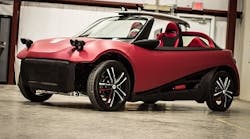When U.S. President Barack Obama stood with German Chancellor Angela Merkl on Sunday to open Hannover Messe, the German industrial trade fair that has grown into the world’s largest, the two world leaders remarked on the strong and enduring partnership between the two industrial superpowers.
Indeed, this year marks that first time that the United States has participated as “Partner Country” in the Fair’s nearly 70-year history. Under the theme of “Integrated Industry,” more than 400 U.S. companies, economic development entities and other organizations are participating in the Fair, amidst more than 5,000 stands from every corner of the globe.
“Germany stands for leadership in precision engineering, and the U.S. is on the cutting edge in software,” remarked Peter Wittig, German ambassador to the United States in a pre-Hannover press event organized by Siemens earlier this month at the Germany embassy in Washington, D.C. The complementary capabilities of the two countries, Wittig said, “set the stage for the digital industry of tomorrow.”
“We believe Hannover Messe is a big deal—an opportunity to discuss policy and show off the latest U.S. technology and innovation to a global audience,” added Bruce Andrews, U.S. deputy commerce secretary. “The event theme of Integrated Industry also alludes to the entwined economies of the U.S., Germany, and Europe overall,” he said.
International cooperation needed
This year’s Hannover Messe also comes at an important moment in history, noted Siegfried Russwurm, chief technology officer and member of the managing board of Siemens AG. “We are entering a new industrial age—not just evolutionary steps, or incremental improvements. We are now merging the worlds of the physical and the virtual. This digitalization of industry will be the driving force for years to come.”
Key to realizing the potential of this digital transformation is cooperation among global stakeholders, Russwurm said. “This paradigm shift cannot be made alone—not by one company, one country, or one government.”
“While each has different strengths and histories, our economies are interdependent,” Russwurm continued. “Customer benefit must drive us forward, to provide interoperability across countries and across economies.” A superordinate solution is required, for example, to bring the concepts of Germany’s Industry 4.0 model for digital industry together with the United States’ Industrial Internet Consortium, Russwurm said. “There is no war of standards: we look forward to closer cooperation to reconcile these complementary approaches.”
Bridging the chasm
If Germany’s engineering prowess together with the United States’ innovativeness in software are the secret sauce that will lead the next industrial revolution, Siemens is positioned as no other to reap the benefits of both cultures.
“We’ve bridged the chasm across the Atlantic,” Russwurm said. As proof, Eric Spiegel, president and CEO, Siemens USA, pointed to the company’s U.S.-based PLM Software division that alone employs some 12,000 individuals. “Globally, Siemens is an $86 billion company, and the U.S. is our largest market at $22 billion,” Spiegel said. “We have 70 manufacturing hubs in the U.S., and are among the top 25 manufacturers in the U.S.”
Key manufacturing capabilities in the states include wind power, rail, industrial turbines and drives. “We believe digitalization will have a significant impact across all our businesses--we’re driving digital technology into all of them.” And with reference to the Industrial Internet of Things, he noted that “at Siemens, we make a lot of things. It’s an opportunity to make a big impact.”


